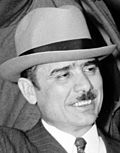History
Minnesota's 8th congressional district was first established after the 1900 census and first contested in 1902. [7] Early settlement patterns of the district were from Northern Europe (especially from the Nordics), [8] leading to a predominantly white, working-class population tied to extractive industries. [9] From 1933 to 1935, the district was temporarily inactive, with representatives elected at-large statewide due to redistricting disputes resolved by the U.S. Supreme Court in Smiley v. Holm (1932). [10] The district had initial Republican dominance but gave way to third-party influences and eventually to the Democratic-Farmer-Labor (DFL) party. [11]
The first representative was Republican James Bede, who served from 1903 to 1909, followed by Clarence B. Miller (Republican, 1909–1919). In 1918, William Leighton Carss won as a Farmer-Labor candidate, serving until 1921 and again from 1925 to 1929 after brief Republican control.
Post-World War II, the district solidified as a DFL stronghold, with John Blatnik serving from 1947 to 1974. He was succeeded by DFLer Jim Oberstar (1975–2011), who chaired the House Transportation Committee and held the seat for 36 years. [12] [13] Redistricting in the 1980s and after usually involved courts due to legislative gridlock. After the 1980 census, a federal court ordered new districts in 1982 following a lawsuit. A similar situation occurred in 1992 (after state and federal court disputes), 2002 (via a judicial panel), and 2012 (following a gubernatorial veto). [14] These changes expanded the district southward and added more rural and suburban areas like Chisago and Isanti counties.
After nearly six decades of comfortably voting DFL, Republican Chip Cravaack defeated Oberstar in 2010 amid discontent with the economy and backlash against the recently passed Affordable Care Act. [15] [16] DFLer Rick Nolan recaptured it in 2012, [17] serving until 2019 after narrow 2014 and 2016 wins. [18] [19] Despite Nolan's win, Donald Trump carried the district by a 15-point margin in the concurrent presidential election. In the 2018 midterm election, it was one of only three congressional districts in the country which flipped to Republican. Republican Pete Stauber won re-elections in 2020, 2022, and 2024 with growing margins each time. [20]
Apportionment
The district was the last district assigned nationwide after both the 2010 and 2020 censuses. After the 2020 census in particular, in spite of early predictions that it would be eliminated, Minnesota held onto the district by a mere 89 people, beating out New York's 27th district for the last spot. [21]
Demographics
The district is mostly rural (61.5%), covering over 27,500 square miles, with a density of around 23 people per square mile. Major industries include health care, retail, and manufacturing, though employment in traditional sectors like taconite mining has declined from 15,000 jobs in the 1970s to about 4,300 today. The district has aged, with median ages in many counties exceeding 40, and education levels have risen, with over 25% of adults in some counties holding bachelor's degrees by 2012. Homeownership is high at 78.3%.
Sex
- Male 50.5% [23]
- Female 49.5%
Ethnicity
Minnesota's 8th district has one of the highest proportions of non-Hispanic whites in the nation. 98.4% of people over the age of 85 are non-Hispanic whites. 86% of those in the 0-4 year old bracket are non-Hispanic white, compared to less than 50% of the nation at large. [24]
- White 92.1%
- Hispanic 1.6%
- Black 1.0%
- Asian 0.7%
- More than one race 2.0%
- Other race 2.6%
Place of birth
- Born in United States 97.8%
- State of residence 78.5%
- Different state 19.1%
- Born in Puerto Rico, U.S. Island areas, or born abroad to American parent(s) 0.4%
- Foreign born 1.9%
Language
Language spoken at home other than English
- Spanish 1.0%
- German 0.4%
- Native American languages 0.4%
- French 0.1%
- Chinese 0.1%
This page is based on this
Wikipedia article Text is available under the
CC BY-SA 4.0 license; additional terms may apply.
Images, videos and audio are available under their respective licenses.















